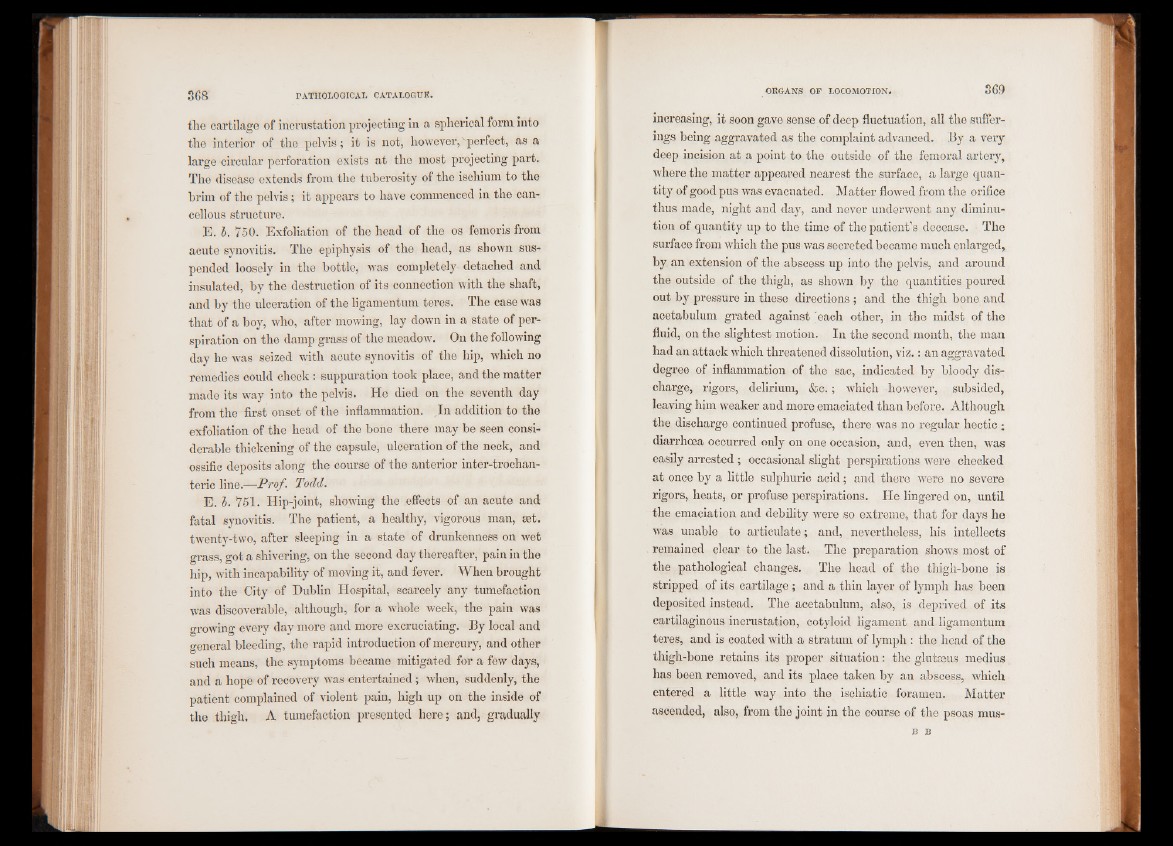
the cartilage of incrustation projecting in a spherical form into
the interior of the pelvis; it is not, however,^perfect, as a
large circular perforation exists at the most projecting part.
The disease extends from the tuberosity of the ischium to the
brim of the pelvis; it appears to have commenced in the cancellous
structure.
E. 1. 750. Exfoliation of the head of the os femoris from
acute synovitis. The epiphysis of the head, as shown suspended
loosely in the bottle, was completely detached and
insulated, by the destruction of its connection with the shaft,
and by the ulceration of the ligamentum teres. The case was
that of a boy, who, after mowing, lay down in a state of perspiration
on the damp grass of the meadow. On the following
day he was seized with acute synovitis of the hip, which no
remedies could check : suppuration took place, and the matter
made its way into the pelvis. He died on the seventh day
from the first onset of the inflammation. In addition to the
exfoliation of the head of the bone there may be seen considerable
thickening of the capsule, ulceration of the neck, and
ossific deposits along the course of the anterior inter-trochanteric
line.—Prof. Todd.
E. 1. 751. Hip-joint, showing the effects of an acute and
fatal synovitis. The patient, a healthy, vigorous man, set.
twenty-two, after sleeping in a state of drunkenness on wet
grass, got a shivering, on the second day thereafter, pain in the
hip, with incapability of moving it, and fever. When brought
into the City of Dublin Hospital, scarcely any tumefaction
was discoverable, although, for a whole week, the pain was
«•rowing every day more and more excruciating. By local and
general bleeding, the rapid introduction of mercury, and other
such means, the symptoms became mitigated for a few days,
and a hope of recovery was entertained; when, suddenly, the
patient complained of violent pain, high up on the inside of
the thigh. A tumefaction presented here; and, gradually
increasing, it soon gave sense of deep fluctuation, all the sufferings
being aggravated as the complaint advanced. By a very
deep incision at a point to the outside of the femoral artery,
where the matter appeared nearest the surface, a large quantity
of good pus was evacuated. Matter flowed from the orifice
thus made, night and day, and never underwent any diminution
of quantity up to the time of the patient’s decease. The
surface from which the pus was secreted became much enlarged,
by an extension of the abscess up into the pelvis, and around
the outside of the thigh, as shown by the quantities poured
out by pressure in these directions ; and the thigh bone and
acetabulum grated against 'each other, in the midst of the
fluid, on the slightest motion. In the second month, the man
had an attack which threatened dissolution, viz.: an aggravated
degree of inflammation of the sac, indicated by bloody discharge,
rigors, delirium, &e.; which however, subsided,
leaving him weaker and more emaciated than before. Although
the discharge continued profuse, there was no regular hectic •
diarrhoea occurred only on one occasion, and, even then, was
easily arrested ; occasional slight perspirations were checked
at once by a little sulphuric acid; and there were no severe
rigors, heats, or profuse perspirations. He lingered on, until
the emaciation and debility were so extreme, that for days he
was unable to articulate; and, nevertheless, his intellects
remained clear to the last. The preparation shows most of
the pathological changes. The head of the thigh-bone is
stripped of its cartilage ; and a thin layer of lymph has been
deposited instead. The acetabulum, also, is deprived of its
cartilaginous incrustation, cotyloid ligament and ligamentum
teres, and is coated with a stratum of lymph : the head of the
thigh-bone retains its proper situation: the gluteus medius
has been removed, and its place taken by an abscess, which
entered a little way into the ischiatic foramen. Matter
ascended, also, from the joint in the course of the psoas mus-
B B